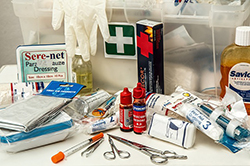 One in 64 children is diagnosed with autism. Coping with the diagnosis and everyday challenges can be stressful for parents. In honor of Stress Awareness Month and Autism Awareness Month, consider effective ways to reduce stress in April and throughout the year.
One in 64 children is diagnosed with autism. Coping with the diagnosis and everyday challenges can be stressful for parents. In honor of Stress Awareness Month and Autism Awareness Month, consider effective ways to reduce stress in April and throughout the year.
Eat a Balanced Diet
Your child may only eat a few foods, but you should eat a balanced diet. Whole, real foods fuel your body, balance your hormones and reduce the effects of stress. If your health insurance covers dietitian services, schedule a helpful consultation.
Exercise
After running around all day, you may not feel like exercising, but regular movement releases endorphins that clear your brain, calm your body and lower your stress. Try running on the treadmill, dancing to music or doing other doctor-approved exercises as you relax.
Practice Good Sleep Hygiene
A good night’s sleep equips you to handle each day’s challenges. To achieve good sleep hygiene:
- Avoid caffeine in the afternoon.
- Practice relaxation techniques before bed.
- Go to bed and wake up at the same time.
If you’re worried about your child waking up or eloping as you sleep, install a baby monitor or bedroom door alarm.
Go to your Happy Place
When you start to feel overwhelmed, close your eyes, think about your favorite place in the world, and feel the sand between your toes or the sun on your face. This guided imagery technique will instantly lower your blood pressure and your stress.
Breathe
A few deep breaths help you slow down, take time to think and calm your body. Breathe in through your nose, hold it and exhale from your mouth whenever necessary.
Get Organized
Juggling doctor appointments and all your parenting and personal duties requires organization. Find an app, calendar or other tool that helps you track and stick to your daily schedule. Getting organized keeps both you and your child calm.
Engage in Self-Care
Every day, drink a cup of hot tea, read a magazine or call a friend. See your doctor for regular physicals, too. Even a five-minute break can remind you of your value and help you feel centered.
Ask for Help
You may not trust many people to care for your child, but try to find one or two trusted family members, friends or professional respite workers who can give you a break. You could also hire someone to clean the house, run errands and ease your burden.
Connect with Other Parents
Find an in-person or online support group and chat with other autism parents. Then share helpful resources, tools and encouragement as you manage everyday life.
Manage stress as you parent your child with autism in these ways. They help you cope successfully with everyday life.

 A rise in temperatures this month can signal spring fever in your office. Your human resources department staff can improve focus and keep everyone on task in several ways.
A rise in temperatures this month can signal spring fever in your office. Your human resources department staff can improve focus and keep everyone on task in several ways. You’re familiar with the physical health benefits your insurance provides, but you may not be familiar with your mental health benefits. These benefits address numerous mental and behavioral health challenges you may face, and you can use them in several ways.
You’re familiar with the physical health benefits your insurance provides, but you may not be familiar with your mental health benefits. These benefits address numerous mental and behavioral health challenges you may face, and you can use them in several ways. Your construction business requires a reliable vehicle. This spring, perform several maintenance procedures on your truck. Routine maintenance equips your truck to operate properly all season and prolongs the life of your vehicle.
Your construction business requires a reliable vehicle. This spring, perform several maintenance procedures on your truck. Routine maintenance equips your truck to operate properly all season and prolongs the life of your vehicle. Unpaid invoices wreak havoc with your construction business. When a client doesn’t pay, you can take these steps.
Unpaid invoices wreak havoc with your construction business. When a client doesn’t pay, you can take these steps. How many times do you walk by fire extinguishers without checking those tags or past first aid kits without peeking inside to assure the contents are complete?
How many times do you walk by fire extinguishers without checking those tags or past first aid kits without peeking inside to assure the contents are complete? When settling Building Insurance claims, it can be tough to determine the real cost of replacing or restoring damaged property. Unfortunately, the methods that policyholders, insurance companies, and agents usually use to set the right amount of coverage all have their weaknesses; according to insurance experts, this means some buildings might be underinsured by up to 40%!
When settling Building Insurance claims, it can be tough to determine the real cost of replacing or restoring damaged property. Unfortunately, the methods that policyholders, insurance companies, and agents usually use to set the right amount of coverage all have their weaknesses; according to insurance experts, this means some buildings might be underinsured by up to 40%! Now that the harsh winter weather has ended, it’s time to spruce up your commercial property. Here are several spring maintenance tips that reduce your liability and prep your property for warmer weather.
Now that the harsh winter weather has ended, it’s time to spruce up your commercial property. Here are several spring maintenance tips that reduce your liability and prep your property for warmer weather. March gives your family the perfect opportunity to talk about love and improve your heart health. Involve your entire family in making positive changes when you take several small heart-healthy steps.
March gives your family the perfect opportunity to talk about love and improve your heart health. Involve your entire family in making positive changes when you take several small heart-healthy steps. Cyber breaches that affect big businesses make the news, but over 60 percent of all cyber breaches target small and medium-sized businesses. Because you must protect your business, no matter what its size, purchase adequate cyber liability insurance.
Cyber breaches that affect big businesses make the news, but over 60 percent of all cyber breaches target small and medium-sized businesses. Because you must protect your business, no matter what its size, purchase adequate cyber liability insurance.



